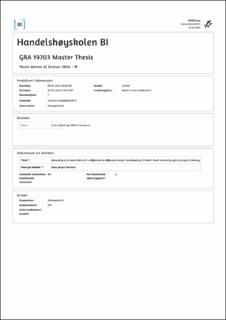Measuring price elasticities with a difference-in-difference design: Investigating the North-South electricity spot price gap in Norway
Master thesis
Permanent lenke
https://hdl.handle.net/11250/3102231Utgivelsesdato
2023Metadata
Vis full innførselSamlinger
- Master of Science [1621]
Sammendrag
This study uses spot price and municipality-level electricity consumption panel data
spanning around three years to derive short run estimates of the price elasticity of
electricity demand (PEED) for the Norwegian residential electricity market. A
difference-in-difference model is applied on an exogenous spot price shock
concentrated in the Norwegian South during 2021 and 2022 which has caused a
strong deviation in electricity prices between the Norwegian price areas. A sample
of municipalities adjacent to both sides of the North-South price border is assigned
to a control (North) and treatment group (South). The main identifying assumption
relied upon is that electricity demand in both groups would follow parallel trends
under the absence of treatment, i.e., the spot price shock. After having validated
that assumption, the study estimates daily, weekly, and monthly values for the spot
PEED. Given indication for a lagged response when using an extension to the
baseline regression model, we infer that our weekly and monthly PEED estimates
better capture the response horizon in this study. Our baseline estimates converge
to -0.02 for both residential housing and cabins. This implies a purchase price
elasticity of demand of -0.12 for residential electricity consumption and -0.05 for
cabins. The purchase PEED estimates are derived by an algebraic approximation
using mean spot prices before and during the major price shock phase, averages for
additional purchase price components, and a government support scheme for
residential electricity consumption. The estimated inelastic demand patterns
confirm previous research for the Norwegian electricity market and are consistent
with the response in aggregate electricity consumption observed in this paper. Our
findings are further discussed with regards to potential non-linearity of price
elasticities which may depend on households’ electricity expenditure-to-income
ratio. Our baseline estimates remain robust for rural Norwegian areas while
providing some evidence for slightly more elastic electricity demand in urban areas.
In the light of the energy transition, an increase in the efficiency of electricity use
is the most straightforward answer to more natural variation in renewable power
generation. However, inelastic residential electricity demand, as shown in this
paper, underlines the urgency for new policy which incentivizes more flexibility in
demand without causing distortions in utility and welfare.
Beskrivelse
Masteroppgave(MSc) in Master of Science in Applied economics - Handelshøyskolen BI, 2023
